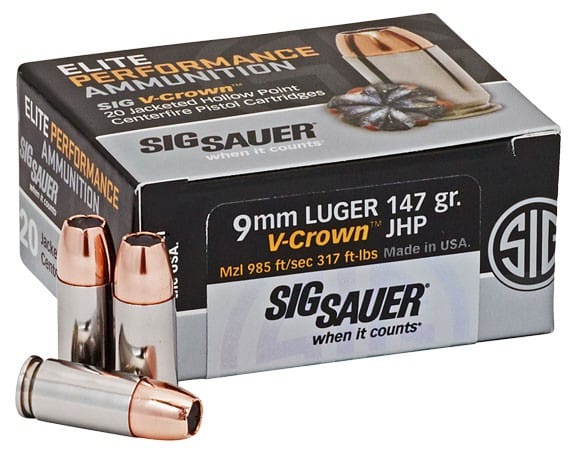Okay new shooter, you’ve narrowed down the right style handgun for you, but now, what caliber? I’ll walk through some popular handgun cartridges so you can a little better acquainted with your options.
Note: This is not intended to be an all-inclusive caliber list, merely an introduction to a few of the more popular handgun rounds available commercially. If they weren’t included in this list, feel free to mention your favorite cartridges in the comments.
First, let’s take a step back: what does “caliber” mean? Caliber is the measurement of the diameter of the bullet, the projectile portion of the cartridge that leaves the barrel. Technically, two rounds may be a the same caliber without being the same round. The cartridge, or round, is the entire unit of ammunition that you load into your firearm (which includes the projectile[s], casing, primer, and powder).
Why should it matter to you? Just like different handgun types, figuring out what uses you have in mind for your firearm will effect which calibers will work best for you. Let’s look into some common calibers and their applications.
Rimfire
.22LR
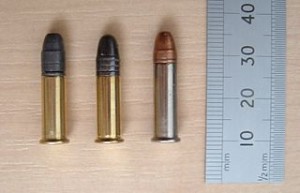
Due to its low recoil, affordability, and, until recent times, wide availability, .22 LR has been the first choice of many new shooters. The .22 is a small, skinny round. As its name denotes, its projectile measures .22 inches in diameter. Because of its position on the low end of the ballistic spectrum, .22 is not largely recommended for self defense; however, those who do choose this cartridge for protection often cite its benefits in capacity and concealment (small round = room for lots of rounds, or a small gun). Despite its small size and low power, accuracy can still be achieved if operating within the effective range of the round (up to 200yds for precision shooters). In fact, several accuracy-based competitions are centered around .22 LR shooting, including NRA Bullseye and Olympic smallbore, and biathalon. My first pistol, the
Centerfire

.380 ACP
The .380 ACP is a step or two up in size from the .22LR. It is another shorter round, with a diameter of .380 in. It may be interesting to note that both .380 and the 9mm (noted below) effectively share the same projectile diameter—both projectiles measure .355 in—however, as you can tell from the image on the left, the casings are different lengths, which has a great effect on the ballistic capabilities of each cartridge. The similarities have given rise to a wide variety of names for the .380 round. It’s also referred to as 9mm kurz (German for 9mm “short”), 9x17mm short, or simply .380 Auto (as opposed to Automatic Colt Pistol/ACP). Like the compact .22, some of the .380’s benefits have to do with its low recoil, and economy of size. The .380 is considered by many to be on the end of the self defense spectrum. As with the .22, there is concern for its lack of penetration and effective range. .380 also tends to be somewhat pricier and somewhat less available than some calibers, like 9x19mm Luger, for example. The Ruger LC 380 pistol is an example of a .380 ACP pistol.
9mm
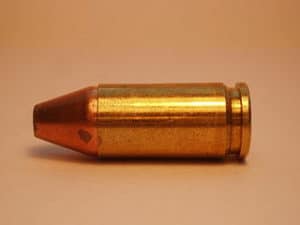
One of the most popular handgun calibers, for shooters of all disciplines and experience levels. Versatile in nature, 9mm ammunition is used in competition, self defense, plinking, and more. The 9x19mm, also known as 9mm Luger or 9mm Parabellum, has more powder behind it than the previously mentioned rounds, so it has a bit more perceived recoil, but it is generally considered to still rest on the gentler end of the spectrum (see 10mm below for comparison). Because of its size economy and ballistic performance, it can be considered a good “compromise” cartridge, as it can be used effectively for compact concealed pistols without much sacrifice to capacity while retaining controllability and ballistic performance. One popular 9mm caliber handgun is the Glock.
.40 S & W
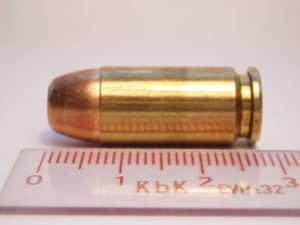
Because the .40 S&W has more punch than the 9mm, it has become popular with law enforcement agencies for use in active shooter situations. And, although the .40 S&W round is similar in size to the 9mm, the .40 was actually developed from the larger 10mm cartridge. Because of the reduction in size, the .40 S&W has similar benefits to the 9mm in size, i.e., increased capacity and concealability, with increased speed and range than its size counterpart, the 9mm. However, because of the higher power round, the .40 S&W is known to give a snappier recoil experience than the smaller calibers we’ve discussed. The Glock 22 pistol is chambered for .40 S&W.
.45 ACP
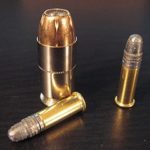
The .45 ACP, also called .45 Auto, has a squat appearance due to its wider diameter. Although it has more powder behind it, and therefore more felt recoil, than the 9mm, it is also considered by many to have a gentler recoil than the .40 S&W. This may be because, although the .45 is wider than the .40, the round travels slower. The perceived recoil effect is to have more of a “push” than a “snap.” This might seem like mincing words, but the average muzzle velocities of both rounds tell the story. An 180gr .40 S&W bullet flies with an average muzzle velocity of ~100o fps, compared to a standard 230gr .45 ACP projectile with an average muzzle velocity of about 850 fps. The .45 is larger, which reduces its capacity/concealability benefits, but it yet remains a versatile cartridge with similar wide ranging applications to the 9mm round, including concealed carry, law enforcement and military service, and competition. One traditional favorite handgun style among .45 afficionados is the 1911.
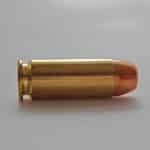
10mm
Considered by some to be the “mother of all semi-auto calibers,” the 10mm round is is the largest, and hardest-recoiling round I’ll mention in this post. Its ballistic capability and size lend well it to self defense use, as well as hunting. There are some who opt to carry 10mm pistols, such as the Glock 20, but others deem the risk of over-penetration too great to use for self defense, namely in highly populated locations. Once considered for use by the FBI (who then scaled down the cartridge to develop the .40 S&W, as mentioned before), the 10mm is a fast round that generates a heavy perceived recoil. Like the other calibers mentioned, there are a variety of 10mm ammo configurations, but one of the most common 10mm variants uses a 200gr bullet and performs with an average muzzle velocity of about 1,200 fps.
This brief selection only represents a few of the more common handgun calibers for semi-automatic pistols. As I mentioned before, if there are other rounds you like that I haven’t included on this list, feel free to mention them in the comments. Part 2 of this series will focus on a few popular rounds used with my favorite kind of handgun: revolvers. Stay tuned!
Featured image courtesy of contributor JoeFotoIS via istockphoto.com

